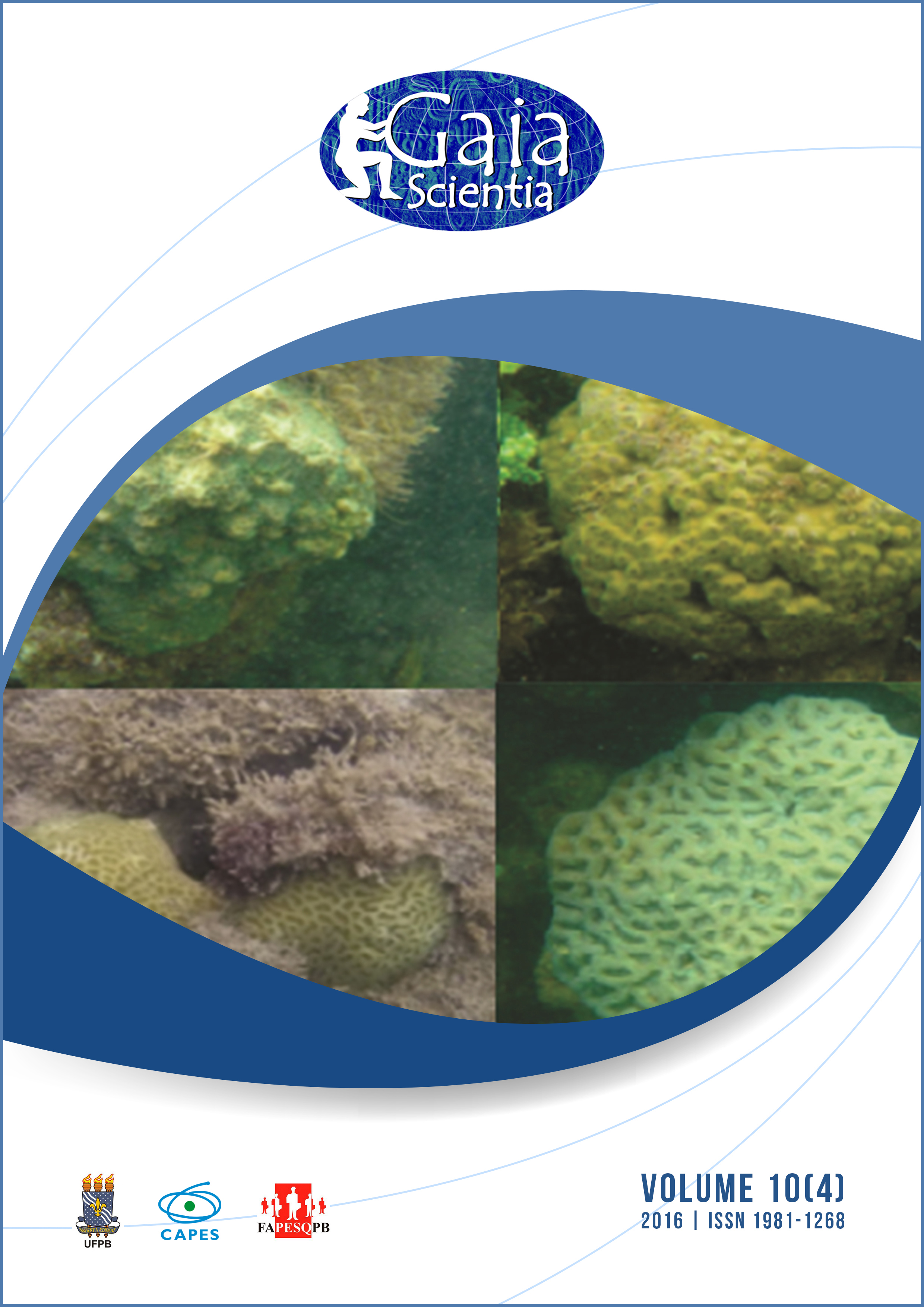Prospection on Yeasts from Stingless Bees Honey in Brazilian Tropical Dry Forest (Caatinga)
Palavras-chave:
Caatinga ecosystem, Fungi, Honeybees, MeliponiniResumo
The richness of the yeasts associated with honey obtained from the stingless bees Melipona mandacaia, M. asilvai, Patarmona sp. and Scaptotrigona sp. living in a Brazilian tropical dry forest (Caatinga) was studied. Based on morphological and physiological characters, a total of 12 species were identified, all belong to Ascomycota, where most isolates showed anamorphic species of Candida. This study has shown that the honey of stingless bees is an important source of yeasts, particularly in tropical dry environments, where the diversity of fungi is still largely unknown.Downloads
Referências
Alves EM, Toledo VAA, Marchini LC, Sereia MJ, Moreti ACCC, Lorenzetti ER, Neves CA, Santos AA. 2009. Presença de coliformes, bolores e leveduras em amostras de mel orgânico de abelhas africanizadas das ilhas do alto rio Paraná. Ciência Rural, 39:2222-2224, doi: 10.1590/S0103-84782009005000140.
Andrade CTS, Marques JGW, Zappi DC. 2006. Utilização medicinal de cactáceas por sertanejos baianos. Revista Brasileira de Plantas Medicinais, 8:36-42.
Brysch-Herzberg M, Lachance M-A. 2004. Candida bombiphila sp. nov., a new asexual yeast species in the Wickerhamiella clade. International Journal of Systematic and Evolutionary Microbiology, 54: 1857-1859, doi: 10.1099/ijs.0.63139-0.
Brysch-Herzberg M. 2004. Ecology of yeasts in plant-bumblebee mutualism in Central Europe. Microbial Ecology, 50: 87-100, doi: 10.1016/j.femsec.2004.06.003.
Calaça PSST. 2011. Aspectos da biologia de Melipona quinquefasciata Lepeletier (Mandaçaia do chão), características físico-químicas do mel, recursos alimentares e leveduras associadas. Msc, dissertation, Universidade Federal de Ouro Preto, Minas Gerais, MG.
Camargo JMF, Garcia MMB, Castrillon A. 1992. Notas prévias sobre a bionomia de Ptilotrigona lurida (Hymenoptera, Apidae, Meliponinae): Associação de leveduras em pólen estocado. Boletim do Museu Paraense Emílio Goeldi - Série Zoologia, 2:391-395.
Cañamás TP, Viñas I, Usall J, Magan N, Solsona C, Teixidó N. 2008. Impact of mild heat treatments on induction of thermotolerance in the biocontrol yaest Candida sake CPA1 and viability after spray-drying. Journal of Applied Microbiology, 3:767-775, doi: 10.1111/j.1365-2672.2007.03590.x.
Coelho MAS, Salgado AM, Ribeiro BD. 2008. Tecnologia enzimática. EPUB-FAPERJ, Rio de Janeiro. 624 p
Ergin Ç, Ilkit M, Kaftanoglu O. 2004. Detection of Cryptococcus neoformans var. grubii in honeybee (Apis mellifera) colonies. Mycoses, 47: 431-434, doi: 10.1111/j.1439-0507.2004.01018.x.
Gilliam M, Roubik DW, Lorenz BJ. 1990. Microorganisms associated with pollen, honey, and brood provisions in the nest of stingless bee, Melipona fasciata. Apidologie, 21:89-97, doi: 10.1051/apido:19900201.
Hammer O, Harper DAT, Rian PD. 2001. Past: Palaeonthological statistics software package for education and data analysis. Version. 1.37. Available in: <http://palaeo-electronica.org/2001_1/past/issue1_01.htm>. (Accessed date: 1 March, 2013).
Hong SG, Bae KS, Herzberg M, Titze A, Lachance M-A. 2003. Candida kunwiensis sp. nov., a yeast associated with flowers and bumblebees. International Journal of Systematic and Evolutionary Microbiology, 53: 367-372, doi: 10.1099/ijs.0.02200-0.
Kerr WE, Carvalho GA, Nascimento VA. 1996. Abelha urucu: Biologia, manejo e conservação. Fundação Acangaú (Coleção da Vida Silvestre), Belo Horizonte, 144p.
Kreger-Van Rij NJW. 1984. The yeast: A taxonomic study. Elsevier, Amsterdam, 1082 p.
Kurtzman CP, Fell JW, Boekhout T. 2011. Yeast: A taxonomic study. Elsevier, Amsterdam, 2354 p.
Lacaz-Ruiz R. 2000. Manual prático de microbiologia básica. EDUSP, São Paulo, 129 p.
Lodder J. 1970. The yeast: A taxonomic study. North Holland Publishing Company, Oxford, 1385 p.
Maia-Silva C, da Silva CI, Hrnci M, de Queiroz RD, Imperatriz-Fonseca VL. 2012. Guia de plantas visitadas por abelhas na caatinga. Fundação Brasil Cidadão, Fortaleza, 191 p.
Michener CD. 2000. The bees of the world. The Johns Hopkins University Press, Baltimore, 913 p.
Morais PB, Rosa CA. 2000. Interações entre Drosophila e leveduras em ambientes tropicais. In: Martins RP, Lewinsohn TM, Barbeitos MS. (Eds.). Ecologia e comportamento de insetos. Serie Oecologia Brasiliensis, vol. VIII. PPGE-UFRJ, Rio de Janeiro, p.321-336.
Nogueira-Neto P. 1997. Vida e criação de abelhas indígenas sem ferrão. Nogueirapis, São Paulo, 445 p.
Peruquetti RC. 2000. Contribuição ao estudo dos microrganismos e artrópodes associados a abelhas sem ferrão (Hymenoptera: Apidae). https://www.ufv.br/DBG/Apiario/inquilinos.pdf. Accessed 26 June 2013.
Phaff HJ. 1990. Isolation of yeasts from natural sources. In: Labeda DP. Isolation of biotechnological organisms from nature. McGraw-Hill, New York, p 53-79.
Pimentel MRC, Antonini Y, Martins RP, Lachance M-A, Rosa CA. 2005. Candida riodocensis and Candida cellae, two new yeast species from the Starmerella clade associated with solitary bees in the Atlantic rain forest of Brazil. FEMS Yeast Research, 5: 875-879, doi: 10.1016/j.femsyr.2005.03.006.
Rosa CA, Lachance M-A, Silva JOC, Teixeira ACP, Marini MM, Antonini Y, Martins RP. 2003. Yeast communities associated with stingless bees. FEMS Yeast Research, 4: 271-275, doi: 10.1016/S1567-1356 (03) 00173-9.
Rosa CA, Martins RP, Antonini Y, Lachance M-A. 1999. Candida batistae, a new yeast species associated with solitary digger nesting bees in Brazil. Mycologia, 9: 428-433.
Schnittler M, Stephenson SL. 2000. Myxomycete biodiversity in four different forest types in Costa Rica. Mycologia, 92: 626-637.
Silveira FA, Melo GAR, Almeida EAB. 2002. Abelhas brasileiras: sistemática e classificação. Ministério do Meio Ambiente, PROBIO-PNUD, Fundação Araucária, Belo Horizonte, 253 p.
Snowdon JA, Cliver D. 1996. Microorganisms in honey. International Journal of Food Microbiology, 31:1-26.
Snowdon JA. 1999. The microbiology of honey-meeting your buyers’specifications (Why they do what they do). American Bee Journal, 1: 51-60.
Souza BA, Marchini LC, Dias CTS, Oda-Souza M, Carvalho CAL, Alves RMO. 2009. Avaliação microbiológica de amostras de mel de trigoníneos (Apidae: Trigonini) do Estado da Bahia. Ciência e Tecnologia de Alimentos, 29:798-802, doi: 10.1590/S0101-20612009000400015.
Teixeira ACP, Marini MM, Nicoli JR, Antonini Y, Martins RP, Lachance M-A, Rosa CA. 2003. Starmerella meliponinorum sp. nov., a novel ascomycetous yeast species associated with stingless bees. International Journal of Systematic and Evolutionary Microbiology, 53: 339-343, doi: 99/ijs.0.02262-0.
Zardo V, Mezzari A. 2004. Os antifúngicos nas infecções por Candida sp. NewsLab, 63:136-146.










